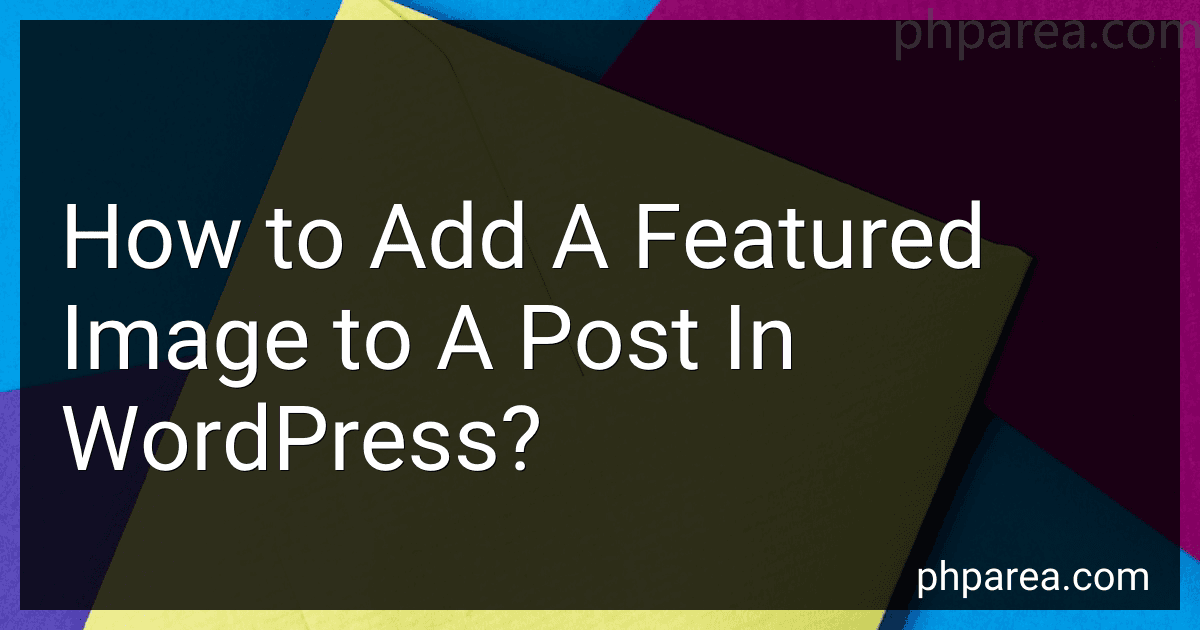Best WordPress Plugins to Buy in December 2025

Professional WordPress Plugin Development, 2nd Edition


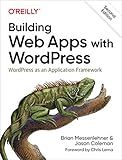
Building Web Apps with WordPress: WordPress as an Application Framework


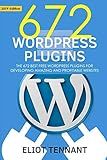
WordPress Plugins: The 672 Best Free WordPress Plugins for Developing Amazing and Profitable Websites



WordPress Plugin Development Cookbook: Create powerful plugins to extend the world's most popular CMS, 2nd Edition



Ultimate WordPress Handbook: An Essential Guide to Designing Stunning WordPress Websites, Driving Traffic, and Boosting Revenue (English Edition)


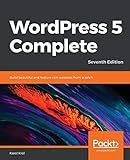
WordPress 5 Complete: Build beautiful and feature-rich websites from scratch, 7th Edition


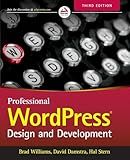
Professional WordPress: Design and Development


To add a featured image to a post in WordPress, you can follow these steps:
- Go to your WordPress dashboard and click on "Posts" or "Add New" if you are creating a new post.
- If you are editing an existing post, find the post you want to add a featured image to and click on "Edit."
- Once you are in the post editor, locate the "Featured Image" box on the right-hand side of the screen.
- Click on the "Set featured image" link in the box. This will open the WordPress media uploader.
- In the media uploader, you can either choose an image from your existing media library or upload a new image by clicking on the "Upload Files" tab and then the "Select Files" button.
- After selecting an image, click on the "Set featured image" button. The selected image will now be set as the featured image for your post.
- You can also provide a title, alt text, caption, and description for the image in the fields provided in the media uploader.
- Once you have added the featured image, you can preview or publish your post to see the image displayed on your website.
Remember that the appearance and location of the "Featured Image" box may vary depending on your WordPress theme and version. However, the process remains similar in most cases.
How to add alt text to a featured image in WordPress for better SEO?
To add alt text to a featured image in WordPress for better SEO, follow these steps:
- Log in to your WordPress dashboard.
- Go to the "Posts" or "Pages" section, depending on where you want to add the alt text.
- Edit the post or page where the featured image is located.
- Find the "Featured Image" section on the right-hand side of the editor and click on the "Set featured image" button.
- Choose or upload the image you want to use as the featured image.
- After the image is uploaded, you will see an "Alt Text" field below it. Click on it to enter your desired alt text.
- Write a descriptive alt text for the image that accurately describes what it represents or shows. The alt text should be concise and relevant to both the image and the content of the post or page.
- Click on the "Set featured image" button to save the changes.
Once the alt text is added, it will help search engines understand the content of the image, which can potentially improve SEO. Make sure to use descriptive and keyword-rich alt text, but avoid keyword stuffing or using irrelevant alt text that does not accurately describe the image.
How to add a custom overlay to a featured image in WordPress?
To add a custom overlay to a featured image in WordPress, you can follow these steps:
- Start by accessing your WordPress admin dashboard.
- Navigate to the "Appearance" menu and click on "Customize".
- In the WordPress Customizer, find the "Additional CSS" option. This is where you will add the CSS code for the overlay.
- Add the following CSS code to create a semi-transparent overlay on the featured image:
.custom-overlay { position: relative; }
.custom-overlay:before { content: ""; position: absolute; top: 0; left: 0; width: 100%; height: 100%; background-color: rgba(0, 0, 0, 0.5); /* Adjust the color and opacity as needed */ z-index: 1; }
- After adding the CSS code, click on "Save & Publish" to apply the changes.
- Now, navigate to the post or page where you want to add the custom overlay to the featured image.
- Edit the post or page, and locate the featured image section. On the right-hand side, you should find a button to set the featured image. Click on it and select or upload the desired image.
- Once the image is selected, click on the "Set Featured Image" button.
- After the image is set as the featured image, you can add the custom overlay by wrapping the featured image code with the following HTML code:
- Save or update the post or page to apply the changes. Now, the featured image should have a custom overlay.
Please note that the CSS code provided is a basic example. You can further customize it by adjusting the colors, opacity, or adding more effects according to your preferences by modifying the CSS code.
How to display the featured image as a background in WordPress?
To display the featured image as a background in WordPress, you can follow these steps:
Step 1: Identify the element where you want to display the background image. This can be a specific section, a div, or any other suitable HTML element.
Step 2: Edit the WordPress template file or the relevant WordPress code with a child theme (if you have one).
Step 3: In your template file or code, locate the element where you want to display the background image and add the following code:
Replace .your-element with the class or ID of your HTML element.
Step 4: Save the changes and upload the modified template file to your WordPress theme's directory or update your WordPress child theme as applicable.
Step 5: Preview your website, and the featured image should now be displayed as the background of the specified element.
Note: Make sure to create a child theme and modify it instead of directly editing the parent theme to prevent losing your changes during theme updates.
How to add a featured image to a specific category archive in WordPress?
To add a featured image to a specific category archive in WordPress, you can follow these steps:
- Start by logging in to your WordPress dashboard.
- Navigate to "Posts" and then "Categories" to find the category you want to add the featured image to. Click on the category to edit it.
- Within the category editor, look for the "Add New Image" or "Set featured image" button. This might be located on the right-hand side or at the bottom, depending on your theme and plugins.
- Click on the button to select or upload an image from your media library. You can also choose to upload a new image directly.
- Once you have selected the image, click on the "Set featured image" button.
- Save your changes by clicking on the "Update" or "Save" button for the category.
- Now, whenever a post is assigned to this specific category, the featured image you added will appear on the category archive page.
Remember that the appearance of the featured image on the category archive page might vary depending on your theme. If it doesn't show up as expected, you may need to consider modifying your template files or using a category-specific plugin to achieve the desired result.
What is the role of a featured image in WordPress SEO?
A featured image in WordPress plays a significant role in SEO (Search Engine Optimization) by improving the visibility and attractiveness of a webpage in search engine results. Here are some reasons why the featured image is important for SEO:
- Visual Appeal: A featured image provides an appealing visual representation of the content, which can attract more visitors to click on the webpage's link in search results. By having a visually appealing image, the chances of users engaging with the post and spending more time on the website increase. Google also considers user engagement signals, such as click-through rates, as a ranking factor.
- Social Media Optimization (SMO): When the webpage is shared on social media platforms, the featured image is often displayed alongside the link. An eye-catching image can increase the likelihood of users clicking, liking, or sharing the post, thereby improving its visibility and exposure.
- Image Search Results: In addition to textual search, search engines also offer image search results. By optimizing the alt text, title, and description of the featured image, the chances of it appearing in image search results increase. This can drive additional traffic to the webpage.
- Rich Snippets: A featured image can be used as a thumbnail in rich snippets or structured data markup. Rich snippets provide additional information about a webpage in search results, making them stand out and increase click-through rates.
- Accessibility and User Experience: Adding a featured image makes the webpage more visually appealing and improves accessibility for visually impaired individuals who use screen readers. By providing a relevant alt text description for the image, it enhances the overall user experience.
To fully optimize a featured image for SEO, it's important to appropriately resize and compress the image, utilize a relevant filename, add descriptive alt text, optimize the image title and caption, and ensure it is visually appealing and relevant to the content.
How to add a hover effect to a featured image in WordPress?
To add a hover effect to a featured image in WordPress, you can follow these steps:
- Open your WordPress dashboard and go to Appearance > Theme Editor.
- Locate and open your theme's style.css file.
- Scroll to the bottom of the file and add the following CSS code:
.featured-image:hover { opacity: 0.8; /* Adjust the opacity value to your desired level */ transition: opacity 0.3s ease; /* Adjust the transition duration to your preference */ }
- Save the changes to the style.css file.
Now, whenever users hover over a featured image on your website, it will have a hover effect with reduced opacity. You can customize the hover effect further by modifying the CSS attributes (e.g., changing opacity, adding box-shadow, etc.) as per your design requirements.
How to add a slideshow of featured images to a post in WordPress?
To add a slideshow of featured images to a post in WordPress, you can follow these steps:
- In your WordPress admin dashboard, go to the post editor where you want to add the slideshow.
- Within the editor, click on the "+" or "Add Block" icon to insert a new block. Search for and select the "Gallery" block.
- Once you have added the Gallery block, you will see an "Add to gallery" button. Click on it to select the images you want to include in your slideshow. You can choose images from your media library or upload new ones.
- After selecting the images, click on the "Create a new gallery" button.
- You can rearrange the order of images, add captions, or delete any unwanted images from the gallery by using the tools provided.
- On the right-hand side of the block editor, you can customize the Gallery block settings. Under the "Block" tab, you can choose different gallery styles, such as a grid or masonry layout.
- Additionally, you can adjust the columns, image sizes, and crop images if needed.
- To enable the slideshow feature, click on the "Advanced" tab on the right sidebar. Toggle the "Enable Carousel Slider" option to display the gallery as a slideshow.
- Once you are satisfied with your settings, click on the "Publish" or "Update" button to save your changes.
After following these steps, your post will display a slideshow of featured images using the Gallery block in WordPress.
